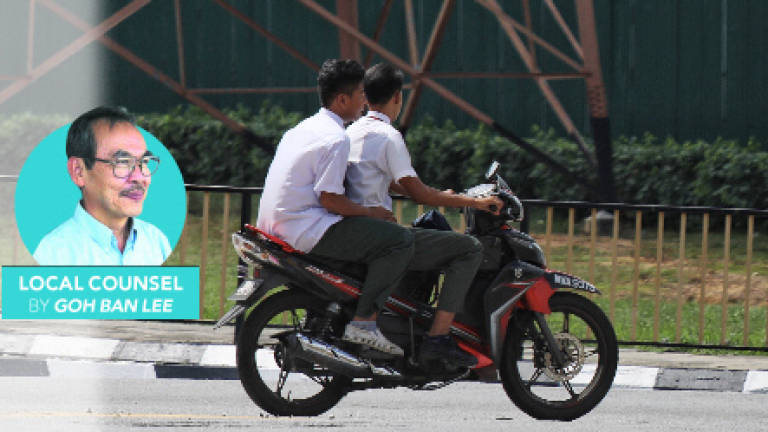Why defy traffic rules?

MOBILITY is an important and necessary part of life. The way we move from one place to another is part of the way we organise our cities and social lives.
A century ago, people would walk from place to place. Those living on coast lines would use their arms to row boats. School children would walk to school if less than 2km away. Some would cycle to their destinations.
A century later, advancement in technology has changed the way we live, and the way we move around. Our ability to travel vast distances is made easier by vehicles.
In many urban neighbourhoods today, not many children walk to school. They either take school buses or are driven in cars.
Older students might be tempted to be more independent. They might use bicycles or even motorcycles. The rich ones might even drive their own cars to school.
This advancement in transport technologies has made our lives easier. We can drive in the comfort and safety of our cars. Motorcycles have enabled poorer people, who might not be able to afford cars, to go to school or work in places further away.
However, this brings about more problems. We now see more students riding motorcycles.
The sad thing is the increase in accidents involving cars and motorcycles. According to the Malaysian Institute of Road Safety Research, 60% of fatalities on the roads last year involved motorcyclists and the youngest victims were aged between 16 and 25.
There were 301 recorded deaths (as of July 12) involving motorcyclists who jumped the red light in the first six months of the year. There were 263 deaths for the same period in 2016.
Are Malaysians driving too fast? Are there too many drunk drivers? Can the roads be upgraded to reduce the number of accidents?
Motorcycles as a humble and convenient means of transport are common in view of the insufficient parking space in city centres. But they are only good for certain speeds. A suitable speed is not more than 30km per hour in busy areas. Although there are road signs and speed limits, many motorists ignore them.
Similarly, it is also common to see children disobeying traffic rules. In many residential areas, including Jalan Permai in Glugor, Penang, it is common to see children without helmets on motorcycles. It is likely that they are too young to have licences. Worse, they opt to carry a pillion or two.
It is unknown whether the concerned parents are aware that their children are riding motorcycles without helmets. These parents are to be blamed for allowing their children to ride motorcycles roaming about aimlessly and obviously only for fun.
Parents should teach their children to do the right thing. They should monitor their whereabouts and activities. Parenting by example is the best way to bring out the best qualities in children.
Most traffic accidents are due to the lackadaisical attitude and road manners of the riders.
According to a news report, casualties among children and teenagers riding motorcycles illegally are on the rise with some as young as six years old putting their lives in danger in the suburbs and rural roads.
“Despite various efforts and law enforcement to deter them from such dangerous acts, our riders choose to remain defiant”, Utusan Malaysia quoted a spokesman from the Traffic Police Enforcement and Investigation Department of Bukit Aman.
Common offences of young motorists are running the red light and reckless riding. They seem to believe that red lights are only meant for cars, lorries and buses. Another common bad habit is weaving in and out instead of keeping to one lane.
Can we do more to balance the needs of young people with their safety and the safety of others?
Datuk Dr Goh Ban Lee is interested in urban planning, housing and local government. Comments: letters@thesundaily.com